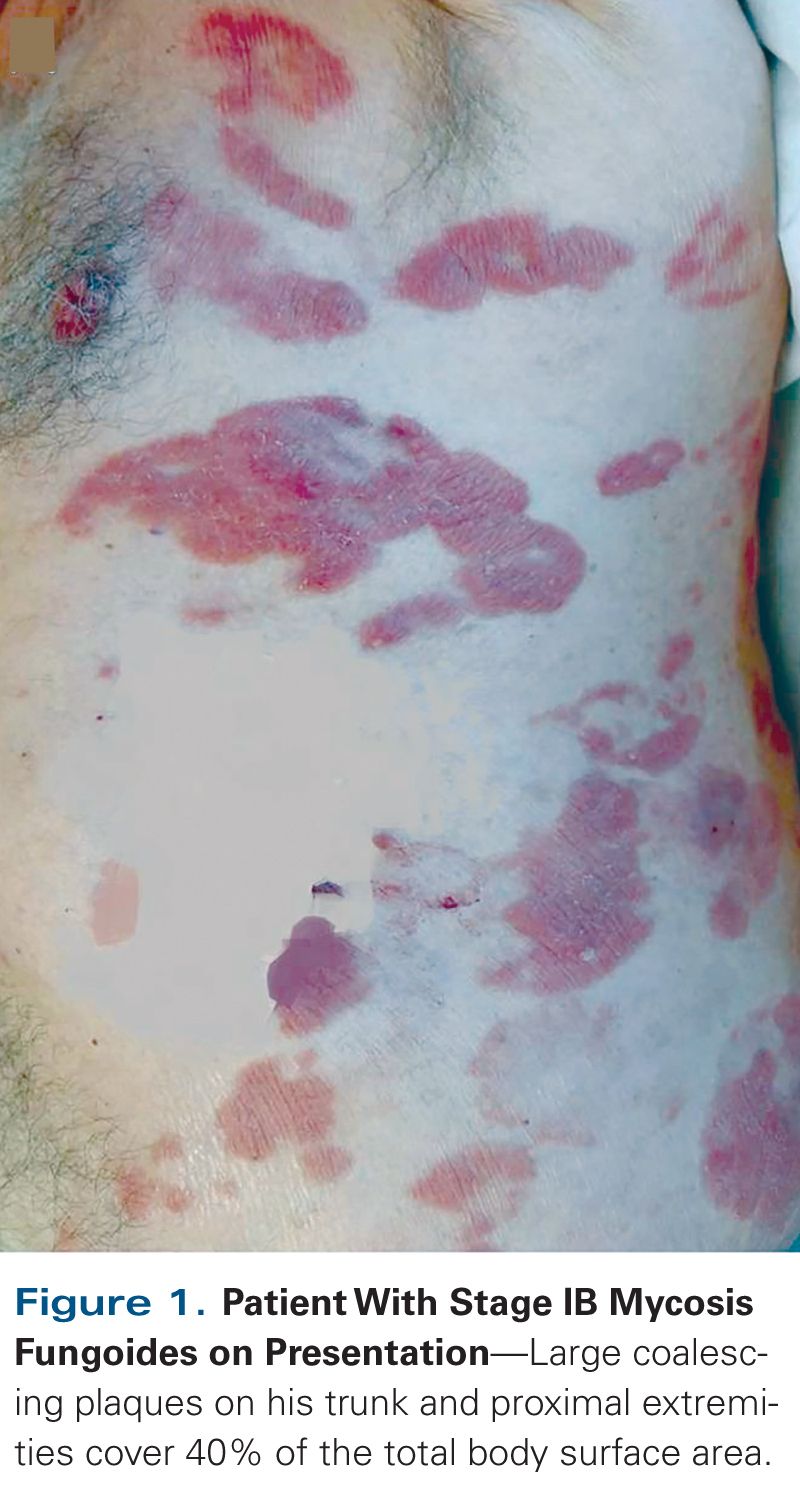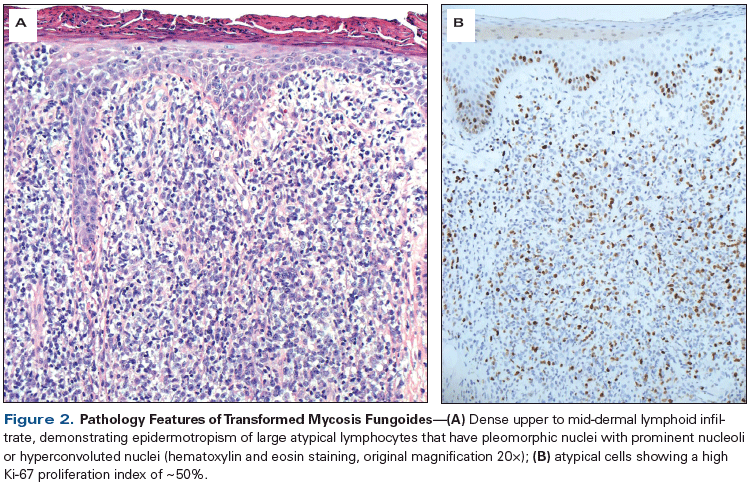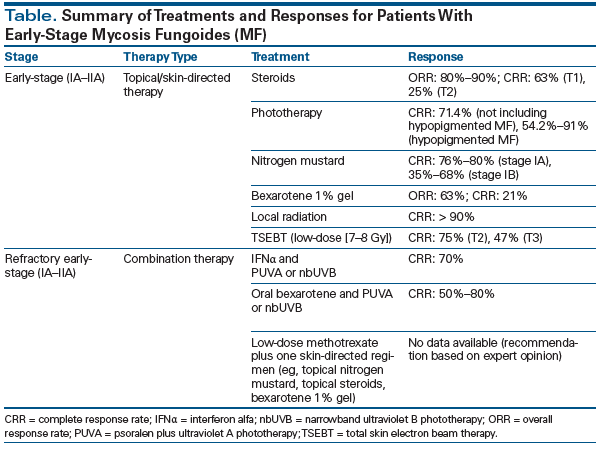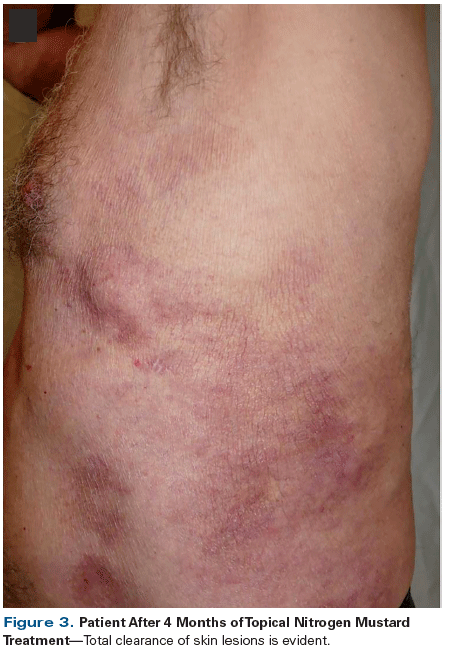The Case
An 80-year-old man presented with a disabling pruritic rash characterized by disseminated and coalescing plaques on the trunk and proximal extremities (Figure 1) and covering 40% of his total body surface area, without peripheral lymphadenopathy. Except for pruritus, he denied other constitutional symptoms, such as fatigue, fever, chills, night sweats, and weight loss.
The skin lesions had started 2 to 3 years ago with a rash on the abdomen and in the groin area that subsequently spread to the entire torso, arms, and buttocks. He was diagnosed with mycosis fungoides in 2013 on the basis of a skin biopsy performed at an outside institution and was treated with 0.1% triamcinolone ointment once a day; he achieved complete remission after 2 months. However, 1 year later he noticed increasing pruritus and new indurated plaques on his trunk and proximal extremities that did not respond to topical steroids, and he was referred to an academic medical center.
New biopsies were performed on skin from the left abdomen and right chest; these revealed a dense upper to mid-dermal lymphoid infiltrate, characterized by epidermotropism of large atypical lymphocytes with hyperchromatic hyperconvoluted nuclei (Figure 2A). These findings were consistent with the diagnosis of mycosis fungoides with large-cell transformation (LCT). The atypical cells were positive for CD3 and CD4, and negative for CD8, with loss of CD7 but preserved CD5 expression. CD30 was negative. The Ki-67 proliferation index was high, at ~50% (Figure 2B). Molecular studies detected a monoclonal rearrangement of the T-cell receptor (TCR) gamma chain gene.
Staging procedures, including whole-body positron emission tomography/computed tomography scans and TCR rearrangement studies in peripheral blood, were negative for systemic disease. Based on these results, mycosis fungoides with LCT was diagnosed; stage was clinical stage IB (T2N0M0B0), according to the revised staging guidelines of the European Organisation for Research and Treatment of Cancer (EORTC) Cutaneous Lymphoma Task Force and the International Society for Cutaneous Lymphomas.[1]
Which of the following represents the best therapeutic approach for this patient?
A. Topical nitrogen mustard.
B. Localized radiation therapy.
C. Daily oral bexarotene or weekly oral methotrexate.
D. Chemotherapy (single/multiagent).
E. Allogeneic stem cell transplant (SCT).
Discussion
Primary cutaneous lymphomas represent ~3.9% of non-Hodgkin lymphomas and comprise various subtypes that encompass markedly heterogeneous entities with differences in histopathologic and clinical presentation. The most common entities, mycosis fungoides and the leukemic variant, Sézary syndrome, account for ~85% of all cases.[2] Although early-stage mycosis fungoides (IA–IIA) has a favorable prognosis and disease is confined to the skin, treatable with skin-directed therapies as first-line regimens, advanced stages (IIB–IVB) are often refractory and have an unfavorable prognosis.
KEY POINTS
- Primary cutaneous
lymphomas have
a very different
prognosis compared
with systemic lymphomas
and require
different treatment
approaches. - Early-stage mycosis
fungoides is
effectively treated
with skin-directed
regimens, even in
cases with large-cell
transformation on
histology. - Systemic agents such
as rexinoids (bexarotene)
and methotrexate
are commonly
used in combination
with skin-directed
regimens for patients
with relapsed or refractory
disease and
early-stage disease. - Systemic chemotherapy
should be considered
only if other
options have been
exhausted, given its
short response duration
and associated
toxicities.
Factors in mycosis fungoides with LCT that are significantly associated with shorter survival include age > 60 years, stage III/IV disease, early onset of transformation (within the first 2 years), and high serum lactate dehydrogenase (LDH) and β-2-microglobulin levels.[3] A recently proposed prognostic index for mycosis fungoides with LCT may be helpful in identifying which patients will have an aggressive clinical course and which will have a more indolent clinical course. Patients with mycosis fungoides with LCT who have two or more adverse prognostic factors (advanced age, folliculotropism, elevated LDH level, peripheral blood clone matching skin clone) have a worse prognosis than patients who have one or no adverse factors.[3] This patient presented with only one adverse factor (age > 60 years), so he can expect the same prognosis as that of those in the general population of the same age and with the same comorbidities. Some studies suggest that transformation at the time of the initial diagnosis may carry a better prognosis compared with development of LCT later in the disease course.[2,3]
All of the answer options listed are used in various settings for the treatment of cutaneous T-cell lymphoma. Given this patient’s age and early-stage disease (clinical stage IB), but with extensive body surface area affected, showing high tumor burden and transformation on histology, options A, B, and C were considered.
Early-stage mycosis fungoides can be effectively treated with skin-directed regimens, with complete response rates (CRRs) ranging from 60% to 100% (Table). Topical steroids, such as 0.05% clobetasol ointment, are usually used as first-line topical treatment, with CRRs varying depending on steroid potency, tumor burden, and total body surface area affected. Bexarotene 1% gel has shown similar response rates, but significant irritation or redness can occur with this agent, and it is less cost-effective. Topical nitrogen mustard has higher CRRs than topical steroids, and it can be used in combination with a topical steroid to achieve maximum benefit while minimizing side effects such as irritation. Phototherapy has a CRR of between 54.2% and 91% in early-stage disease but is not effective in patients with infiltrated plaques and tumors,[4] such as this man. In general, however, mycosis fungoides with LCT does not require a different treatment than classic mycosis fungoides of a similar stage. Localized radiation therapy (Answer B) is considered in patients with unifocal transformation, isolated/localized skin tumors, or chronic painful/ulcerated lesions; it is associated with a CRR of > 90% and a mean time to relapse of 9.25 months (range, 5–14 months).[5] However, localized radiation was not favored in this patient because of the extensive body surface area involved. Extensive radiation therapies, such as total skin electron beam radiation, should be reserved for rapidly progressing or refractory widespread plaques and tumors, as well as for patients with advanced-stage disease, since long-term side effects can lead to cosmetic disfigurement (permanent hair loss, pigmentation) and the development of skin cancers, and can require that subsequent radiation be limited or forgone altogether.
Systemic biologic modifying agents, such as rexinoids (oral bexarotene) or methotrexate (Answer C), are commonly used as first-line monotherapy in advanced mycosis fungoides and are also used in low doses in combination with skin-directed regimens (narrowband ultraviolet B [UVB] or psoralen plus ultraviolet A [PUVA] phototherapy, topical steroids, topical nitrogen mustard, or spot radiation) for patients with relapsed or refractory early-stage disease.[6,7] Decreased or defective Fas expression by neoplastic T cells, leading to impaired Fas-mediated apoptosis, has been associated with advanced/aggressive mycosis fungoides, as well as with transformed mycosis fungoides.[8] By decreasing promoter methylation, methotrexate increases Fas and Fas-ligand in mycosis fungoides, resulting in enhanced Fas pathway apoptosis. Low-dose weekly methotrexate has an overall response rate (ORR) of 33% for plaque-stage (T2) mycosis fungoides and 58% for erythrodermic (T4) disease, with a median time to treatment failure of 15 months for patients with stage T2 disease and 31 months for those with erythrodermic mycosis fungoides.[9,10] Common side effects of methotrexate include oral mucositis/stomatitis, gastrointestinal symptoms, bone marrow suppression, and elevated transaminase levels. Oral bexarotene has been approved by the US Food and Drug Administration (FDA) for refractory cutaneous T-cell lymphoma of all stages. It has demonstrated an ORR of 61% and a CRR of 21% in early-stage disease; the CRR increases to 50% to 80% when bexarotene is given in combination with phototherapy (PUVA or narrowband UVB) in patients with refractory early-stage disease.[11,12] A daily dosing regimen of 300 mg/m2 is recommended based on the safety profile. The most common side effects of bexarotene include hypertriglyceridemia, hypercholesterolemia, and central hypothyroidism, requiring dose adjustments, lipid-lowering agents, and thyroid medications.
Because this patient was considered to be essentially treatment-naive, since the only therapy he had received was inconsistent use of low-potency topical steroids, we opted to initiate treatment with a skin-directed regimen. Because he had early-stage disease but extensive body surface area affected and LCT on histology (stage IB), we opted for a regimen of topical nitrogen mustard at bedtime (Answer A), along with 0.05% clobetasol ointment in the morning. If no significant response had been achieved within a few months and/or progression had been noted, a single biologic modifying agent would have been added and would represent the next step in the patient’s treatment.[13]
Single-agent chemotherapy, such as gemcitabine or liposomal doxorubicin, can be an option[14,15] for extensive widespread tumor-stage mycosis fungoides. Multiagent chemotherapy can be used in cases of systemic disease or unequivocal lymph node involvement, but a careful risk/benefit assessment and comparison with other treatment regimens should be performed. A recent retrospective study analyzed ~200 patients with mycosis fungoides or Sézary syndrome who underwent at least three systemic therapies. The primary endpoint was time to next treatment (TTNT). The median TTNT was 8.7 months for interferon alfa, 4.5 months for histone deacetylase inhibitors, and 3.9 months for single/multiagent chemotherapy.[13] The study highlights the fact that systemic chemotherapy should be considered only if other options have been exhausted, given its short response duration and associated toxicities, which include infectious complications. Hence, Answer D is not correct for this patient.
Allogeneic SCT is the only potential curative treatment option for mycosis fungoides.[16] A proposed graft-vs-lymphoma effect is thought to be responsible for the higher effectiveness of allogeneic transplants; autologous transplants have yielded disappointing results, with rapid disease relapses.[17] However, treatment-related mortality rates for allogeneic SCT are about 25% to 30%, even with the use of myeloablative and reduced-intensity conditioning regimens.[18] Therefore, allogeneic SCT is usually reserved for young patients with refractory and advanced-stage mycosis fungoides. Given this patient’s age and disease stage, Answer E is incorrect.
Outcome of This Case
The patient was started on topical 0.016% nitrogen mustard gel to the affected areas at bedtime. Because of the local irritation associated with this agent, a high-potency topical steroid, 0.05% clobetasol ointment, was added in the morning; the patient achieved complete remission within 4 months (Figure 3). He has remained in nearly complete remission for the last 14 months, with only a few recurrent plaques noticed, which responded to reapplication of nitrogen mustard. His pruritus subsided with the clearance of his skin lesions, but until these cleared, he was significantly disabled by his pruritus, for which he was given a first-generation antihistamine (hydroxyzine, 25 mg at bedtime), which controlled the itching to a moderate degree. Gabapentin or aprepitant were other considerations if antihistamines had proved ineffective. Skin care using unscented mild soaps and emollients was recommended to ameliorate the pruritus and dryness/scaling, and to keep barrier function intact. Weekly bleach baths were implemented to minimize bacterial colonization with Staphylococcus aureus.
Financial Disclosure:The authors have no significant financial interest in or other relationship with the manufacturer of any product or provider of any service mentioned in this article.
E. David Crawford, MD, serves as Series Editor for Clinical Quandaries. Dr. Crawford is Professor of Surgery, Urology, and Radiation Oncology, and Head of the Section of Urologic Oncology at the University of Colorado School of Medicine; Chairman of the Prostate Conditions Education Council; and a member of ONCOLOGY's Editorial Board.
If you have a case that you feel has particular educational value, illustrating important points in diagnosis or treatment, you may send the concept to Dr. Crawford at david.crawford@ucdenver.edu for consideration for a future installment of Clinical Quandaries.
References:
1. Olsen E, Vonderheid E, Pimpinelli N, et al. Revisions to the staging and classification of mycosis fungoides and Sezary syndrome: a proposal of the International Society for Cutaneous Lymphomas (ISCL) and the cutaneous lymphoma task force of the European Organization of Research and Treatment of Cancer (EORTC). Blood. 2007;110:1713-22.
2. Jawed SI, Myskowski PL, Horwitz S, et al. Primary cutaneous T-cell lymphoma (mycosis fungoides and Sezary syndrome): part I. Diagnosis: clinical and histopathologic features and new molecular and biologic markers. J Am Acad Dermatol. 2014;70:205.e1-e16; quiz 221-2.
3. Benner MF, Jansen PM, Vermeer MH, Willemze R. Prognostic factors in transformed mycosis fungoides: a retrospective analysis of 100 cases. Blood. 2012;119:1643-9.
4. Jawed SI, Myskowski PL, Horwitz S, et al. Primary cutaneous T-cell lymphoma (mycosis fungoides and Sezary syndrome): part II. Prognosis, management, and future directions. J Am Acad Dermatol. 2014;70:223.e1-e17; quiz 240-2.
5. Thomas TO, Agrawal P, Guitart J, et al. Outcome of patients treated with a single-fraction dose of palliative radiation for cutaneous T-cell lymphoma. Int J Radiat Oncol Biol Phys. 2013;85:747-53.
6. Zelenetz AD, Gordon LI, Wierda WG, et al. NCCN clinical practice guidelines in oncology: non-Hodgkin’s lymphoma. 2016; v 3.2016. http://www.nccn.org/professionals/physician_gls/f_guidelines/pdf/nhl.pdf. Accessed September 15, 2016.
7. Huber MA, Staib G, Pehamberger H, Scharffetter-Kochanek K. Management of refractory early-stage cutaneous T-cell lymphoma. Am J Clin Dermatol. 2006;7:155-69.
8. Wu J, Nihal M, Siddiqui J, et al. Low FAS/CD95 expression by CTCL correlates with reduced sensitivity to apoptosis that can be restored by FAS upregulation. J Invest Dermatol. 2009;129:1165-73.
9. Zackheim HS, Kashani-Sabet M, Hwang ST. Low-dose methotrexate to treat erythrodermic cutaneous T-cell lymphoma: results in twenty-nine patients. J Am Acad Dermatol. 1996;34:626-31.
10. Zackheim HS, Kashani-Sabet M, McMillan A. Low-dose methotrexate to treat mycosis fungoides: a retrospective study in 69 patients. J Am Acad Dermatol. 2003;49:873-8.
11. Duvic M, Martin AG, Kim Y, et al. Phase 2 and 3 clinical trial of oral bexarotene (Targretin capsules) for the treatment of refractory or persistent early-stage cutaneous T-cell lymphoma. Arch Dermatol. 2001;137:581-93.
12. Querfeld C, Rosen ST, Guitart J, et al. Comparison of selective retinoic acid receptor- and retinoic X receptor-mediated efficacy, tolerance, and survival in cutaneous T-cell lymphoma. J Am Acad Dermatol. 2004;51:25-32.
13. Hughes CF, Khot A, McCormack C, et al. Lack of durable disease control with chemotherapy for mycosis fungoides and Sezary syndrome: a comparative study of systemic therapy. Blood. 2015;125:71-81.
14. Duvic M, Talpur R, Wen S, et al. Phase II evaluation of gemcitabine monotherapy for cutaneous T-cell lymphoma. Clin Lymphoma Myeloma. 2006;7:51-8.
15. Dummer R, Quaglino P, Becker JC, et al. Prospective international multicenter phase II trial of intravenous pegylated liposomal doxorubicin monochemotherapy in patients with stage IIIB, IVA, or IVB advanced mycosis fungoides: final results from EORTC 21012. J Clin Oncol. 2012;30:4091-7.
16. Duarte RF, Boumendil A, Onida F, et al. Long-term outcome of allogeneic hematopoietic cell transplantation for patients with mycosis fungoides and Sézary syndrome: a European Society for Blood and Marrow Transplantation Lymphoma Working Party extended analysis. J Clin Oncol. 2014;32:3347-8.
17. Wu PA, Kim YH, Lavori PW, et al. A meta-analysis of patients receiving allogeneic or autologous hematopoietic stem cell transplant in mycosis fungoides and Sezary syndrome. Biol Blood Marrow Transplant. 2009;15:982-90.
18. Duarte RF, Canals C, Onida F, et al. Allogeneic hematopoietic cell transplantation for patients with mycosis fungoides and Sezary syndrome: a retrospective analysis of the Lymphoma Working Party of the European Group for Blood and Marrow Transplantation. J Clin Oncol. 2010;28:4492-9.




